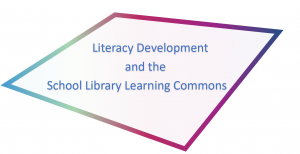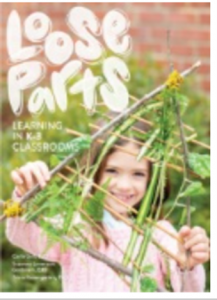In last week’s blog post, I discussed how I was inspired by the 21st century ideal of the School Library Learning Commons, and the multitude of possibilities and opportunities for gathering, learning, and exploring that is provided to all community stakeholders when traditional spaces are transformed into these active, vibrant hubs.
I generated a wordle to determine what ideals were repeatedly hit on. Concepts such as School Library Learning Commons, physical space, imagination, students, inquiry, virtual, access, play, elementary, and story captured my attention, and lead me closer to where my philosophy about the role of the SLLC and student learning lies.

Key words I mentioned last week were:
- School Library Learning Commons
- Accessibility
- Creativity
- Physical space
- Virtual space
- Technology
- Digital tools
- Exploration stations: maker space, coding, story workshops
- Imagination
- Innovation, problem

In this week’s blog post, I wanted to focus on one to two key areas for inquiry that an Elementary School Library Learning Commons will promote for literacy development: the virtual SLLC and loose parts to facilitate story workshops and examine a few resources that I found useful in understanding the ideas and applications.
In this week’s course reading of Chapter 3, “Be a Champion”, Leading from the Library, a couple of key points resonated with me as I began to whittle away at my ideas for this week’s blog post. These being, “Don’t forget to connect the work that your students do and the programming that you design to the overall goals of the school”, and “Another great opportunity to be a champion in the library is to amplify the voices of your students” (Bass, 2019). My elementary school has literacy goals in reading and writing as part of their school plan and many teachers look to the SLLC for resources and ideas to enrich their literacy programs for students. One area the SLLC took on this year to promote student engagement and foster student self-confidence was to participate in this year’s Battle of the Books competition. An example of this will be shown in a video clip later in this blog. Leading from the Library was a great resource to get me thinking about what an SLLC can do in areas of literacy, but I needed more. Next, I looked at the Canadian School Libraries website for more details.
In “Leading Learning: Standards of Practice for School Library Learning Commons in Canada”, Canadian School Libraries supports the ideal that School Library Learning Commons should take the lead in fostering literacy initiatives and, assist “learners to hone and apply an expanded notion of literacy as well as fostering an active reading culture” (Canadian School Libraries (CSL), 2023). The CSL categorize literacies into 7 themes: Literacy Leadership, Engaging Readers, Information Literacy, Critical Literacy, Digital Literacy and Citizenship, Cultural Literacy, and Literacy Partners. Click on this link to see the table to read further and access live links for each section. For my purposes, I focused on the ideas and resources for Literacy Leadership and Engaging Readers.
According to the Growth Indicators listed in the table, an established SLLC has “students engage in face-to-face and virtual book clubs based on their interests”, and the “LLC Leadership team designs and applies learning experiences to nurture all literacies” (Canadian School Libraries (CSL), 2023). A wonderful example of promoting and fostering student engagement in literacy is the Battle of the Books yearly event held across many schools in the province. Watch some of this YouTube video provided by Kingsford Elementary School showcasing their student book club’s 2023 Battle of the Books event.
(Kingsford Elementary School, 2023)
In this video, Richmond School District (SD38), provides many examples of what established SLLC leaderships teams have achieved in the transformations of their elementary and secondary libraries into School Library Learning Commons.
(Richmond School District SD#38, 2021)
Established SLLC’s combine the virtual space and the physical space. Richmond School District SLLC’s are demonstrating that their spaces go far beyond that of a repository for physical learning materials. Many of the elementary SLLC’s housed loose parts for story workshops, and asked questions of students such as, “What stories live in these materials?” The use of loose parts is one of many modes to employ that meet the varied needs of today’s diverse, 21st century learner.

“Materials support the different languages that children speak … they teach children different languages too” (Stockman, 2020).
Writing is a component of literacy that many young students struggle with. Print is one of the most difficult modes to master in the elementary years. Much research has been done that supports a multimodal approach to teaching the writing process. The Reggio Emilia concept of story workshop, and multimodal forms of expression have fascinated me for several years, and now that I am embarking on the Teacher-Librarian journey I am interested in how the SLLC can foster this exploratory method of storytelling.
Loose parts are not seen as toys, but as materials with stories to share. In her book, “Creating Inclusive Writing Environments in the K-12 Classroom”, Stockman explains that in the multimodal environment students “make writing” (Stockman, 2020). Stockman uses the graphics below to illustrate what this process may look like during multimodal play. She supports the idea that, “writing is multimodal”, and if we are to foster this for our students then we, “… must create environments that foster the development of their multimodal literacies” (Stockman, 2020). The environment of a School Library Learning Commons aligns with these ideals and modes of expression.

from page 132 (Stockman, 2020).
For ideas on the use and curation of loose parts, I am reading this gem, “Loose Parts Learning in K-3 Classrooms” by Carla Gull, Suzanne Levenson Goldstein, and Tricia Rosengarten. More on the ideas from here next time.

(Carla Gull, 2021).
I am curious about the role and impact of the virtual SLLC. With the development of thousands of new apps and more affordable options for touchscreen devices, the SLLC must have an equally dynamic virtual presence and impact on student engagement and learning as the physical space. Once recent study published in the journal, PEDIATRICS, titled “Apps as Learning Tools: A Systematic Review” concluded that young children under the age of 6 improve their learning of math and language arts concepts with the use of high-quality learning apps (Shayl F. Griffith, 2020). Given this evidence, the virtual SLLC should link the OPAC and approved learning apps to promote greater engagement and accessibility for all stakeholders of the school community. This video provided by Waterloo Region District School Board illustrates what an effective virtual SLLC can provide.
(Waterloo Region District School Board, 2022).
For two areas of focus, this is a lot to take in and process, but I cannot help but continue to be excited by the possibilities these components can bring to the students’ experience in an established School Library Learning Commons. I hope you’ve been inspired by the ideas presented and feel invited to be curious about what you could create and express in these multimodal forms in your classroom and School Library Learning Commons.
Works Cited
Bass, S. M. (2019). Leading from the Library: Help Your School Community Thrive in the Digital Age. Portland: International Society for Technology in Education.
Canadian School LIbraries (CSL). (2023, May 27). Fostering Literacies to Empower Life-Long Learners. Retrieved from Leading Learning: Standards of Practice for School Library Learning Commons in Canada: https://llsop.canadianschoollibraries.ca/
Carla Gull, S. L. (2021). Loose Parts Learning in K-3 Classrooms. Newburyport: Gryffinhouse, Inc.
Kingsford Elementary School. (2023, February). 2023 Battle of the Books – YouTube Video. Vancouver, British Columbia, Canada.
Richmond School District SD#38. (2021). Transforming Library Spaces: SD38 Richmond. Innovation Grants, LES Grants, Seismic Upgrades. Richmond, British Columbia, Canada.
Shayl F. Griffith, M. B. (2020, January). Apps as Learning Tools: A Systematic Review. PEDIATRICS, 145, p. 14. Doi:https://doi.org/10.1542/peds.2019-1579
Stockman, A. (2020, September 8). Creating Inclusive Writing Environments in the K-12 Classroom: Reluctance, Resistance, and Strategies that Make a Difference. (1st). New York: Routledge. Doi: https://doi.org/10.4324/9781003028260
Waterloo Region District School Board. (2022). How To Access the WRDSB Library Learning Commons Online. Waterloo, Ontario, Canada.

This is an excellent post. You have curated, linked, and annotated a strong list of resources to support your inquiry. You have a solid foundation here for future work. I appreciate your thorough and thoughtful annotations, the inclusion of multimedia elements and the links you make back to our course text. Something you might want to try adding to your posts is categories. These will help your audience navigate your blog as it grows